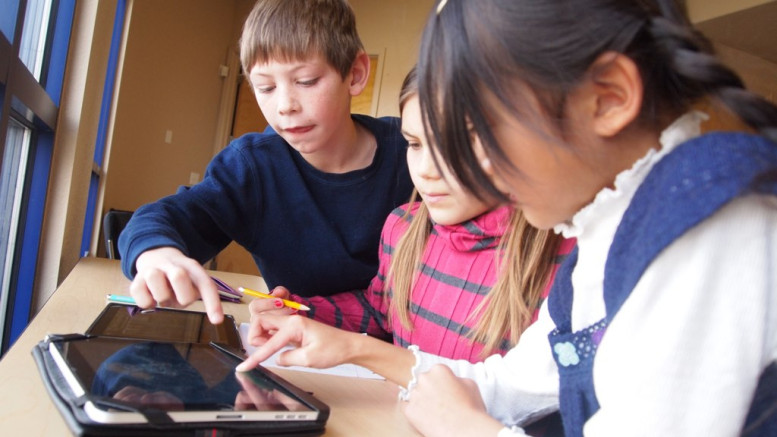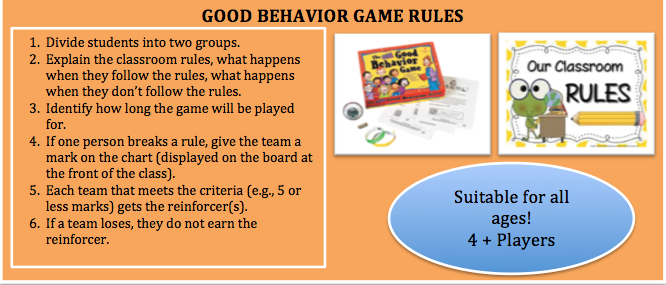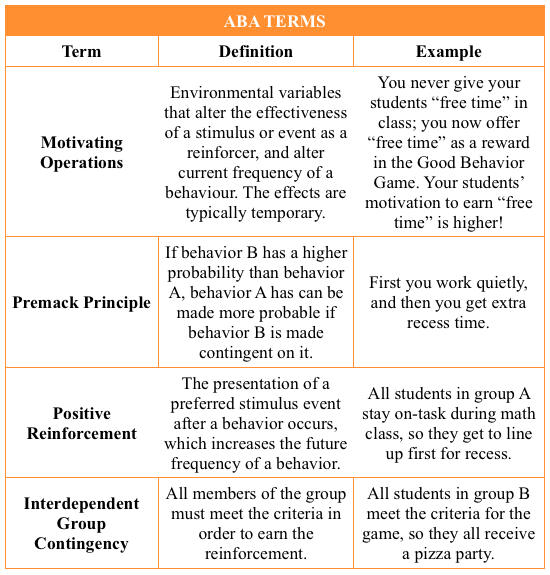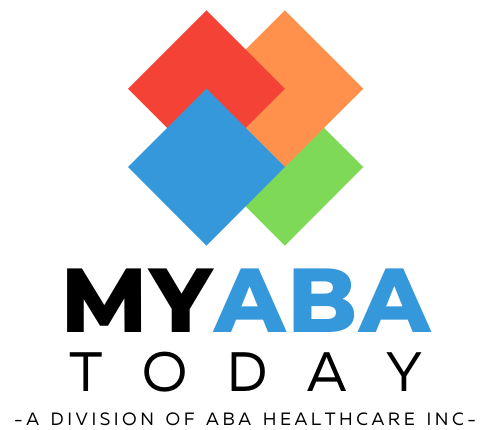Do you want to play a game?
If you asked your students this question, my guess is that you would get some enthusiastic yeses! Because who doesn’t want to play a game at school?
Applied Behavior Analysis (ABA) has an evidence-based strategy that’s just that – a game! The Good Behavior Game (GBG) teaches students a number of skills, including appropriate classroom behaviors. The GBG has been used successfully in various types of classrooms, with elementary and high school students, and has been recommended as a promising practice by the Surgeon General as a tool for youth violence prevention (U.S. Department of Health and Human Services, 2001).
The game uses various behavior analytic principles, including: motivating operations, the Premack Principle, and positive reinforcement delivered using an interdependent group contingency. The name of the game implies that “good” behaviors are reinforced, except in this game, it’s the absence of inappropriate behaviors that are reinforced, and the expectations are gradually increased (A tip to behavior analysis students – you may want to look into types of differential reinforcement!). In the game, contingencies are set for both following and breaking the rules. And if you’re wondering, yes competition is inherently a part of the game, however, it is set up in a way that encourages peers to help each other, and all teams can win!
There are some variations to the game that have been developed since the first empirical research was done by Barrish, Sauders & Wolf (1969), but here are some general rules:
As a teacher, here is what you have to do:
Identify the target behaviours. – Common behaviours used in research are: getting out-of-seat, talking-out, and aggression.
Operationally define all target behaviours. – What do each of the behaviours look and sound like? This will help you and others record accurate data and increase treatment efficacy.
Develop the classroom rules. – Base the rules on the target behaviours, write them on a board, and remember to include pictures!
Decide when you’re going to play the game. – Remember to start the game for short periods of time, and then gradually increase it throughout the day.
Conduct preference assessments. – Identify possible reinforcers your students will work for.
…and most importantly, have fun playing the game with your students!
Implementing the GBG is a whole-class behavior management strategy that works. If you’re thinking of playing this with your students, ensure you have sufficient training, record data, and give yourself and students time to learn the game. I recommend you contact a Board Certified Behavior Analyst (BCBA) who has experience with the GBG to help you set it up for your students.
Here’s a look at the first published research on the GBG and a cheat sheet on the terminology used in this article.
Also check out another bSci21 article summarizing GBG research, as well as tips for classroom management.
REFERENCES
Barrish, H. H., Saunders, M. S., & Wolf, M. M. (1969). Good behavior game: Effects of individual contingencies for group consequences on disruptive behavior in a classroom. Journal of Applied Behavior Analysis, 2, 119–124.
Donaldson, J.M., Vollmer, T.R., Krous, T., Downs, S., & Berard, K.P. (2011). An evaluation of the good behavior game in kindergarten classrooms. Journal of Applied Behavior Analysis, 44, 605-609.
Embry, D. D. (2002). The good behavior game: a best practice candidate as a universal behavioral vaccine. Clinical Child and Family Psychology Review, 5, 273–297.
Harris, V. W., & Sherman, J. A. (1973). Use and analysis of the ‘‘good behavior game’’ to reduce disruptive classroom behavior. Journal of Applied Behavior Analysis, 6, 405–417.
Tingstrom, D.H., Sterling-Turner, H.E., & Wilczynski, S.M. (2006). The good behavior game: 1969-2002. Behavior Modification, 30, 225-253.
U.S. Department of Health and Human Services. (2001). Youth violence: A report of the Surgeon General. Rockville, MD: Author.












